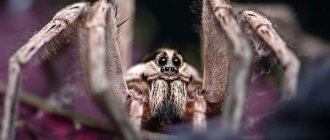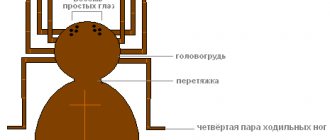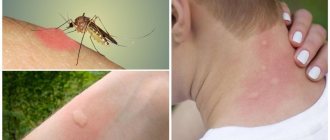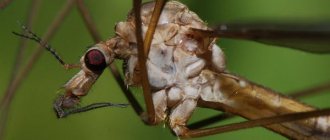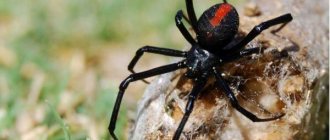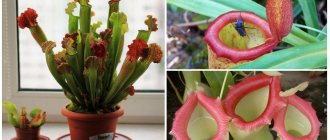What kind of Argiope is this?
Argiope Bruennichi (lat. Argiope Bruennichi) or wasp spider, also known as Argiope the orb-weaver. An insect with a bright appearance. It is named so not only because of its black and yellow stripes. His waist is just as small and he can fly! Not on the wings, of course, on the threads of the web, which are picked up by the wind.
A little help:
The official name of the wasp spider is Argiope Bruennichi:
Argiope is a nymph from ancient Greek myths (250 years ago it was fashionable to name insects after mythological heroes);
Brünnich is the name of a Danish zoologist who published a major book on insectology in the late 1700s (full name: Morten Trane Brünnich).
Argiope's appearance
Even fierce opponents of arachnids find the Argiope Brünnich spider beautiful. It is more popularly known by other names: wasp spider, tiger spider, and less commonly, zebra spider. And all thanks to the bright, original, memorable coloring. While fully consistent with a spider's physique, the animal has a characteristic wasp (or tiger) coloring: yellow and black stripes. If you look closely, they are interspersed with white lines, but from a distance the coloring completely matches that of wasps. The spider's legs are also ringed with contrasting stripes, creating a clear impression that they are wearing stockings. Clearly on the fourth stripe, if you count from the cephalothorax, there are two noticeable tubercles, and along the edges of the abdomen there are notches (always six, but colored differently: shades vary from inexpressively dark to bright orange).
The arrangement of the limbs of the wasp spider is also non-standard. Two pairs are oriented strictly forward, the remaining two are oriented strictly backward. Visually, there are no lateral supports, which is not typical for most arachnids, in which the legs are located perpendicular to the surface.
Argiope Brünnich cannot boast of impressive size. Males never exceed seven millimeters in “height” - most people will not notice them, especially since their coloring is rather dull. Females will be larger: they can reach 2.5 centimeters, distinguished by bright colors that are noticeable from afar.
Spider wasp: description, structure, characteristics
The females of Argiope brunnich look like a wasp. All are black and yellow, but the designs on the back are still different (two young ladies at the same party in the same outfits? Are you kidding me?)
Photo of a wasp spider.
The scientific classification of the Argiope spider is as follows:
- phylum : arthropod,
- class : arachnids (who would doubt it!),
- squad : spiders (thank you, Captain Obvious),
- suborder : Opisthothelae (arachnoid warts are located at the back, there are no nerve ganglia in the abdomen, but there are poisonous glands),
- infraorder : araneomorphic spiders (jaws move like scissors),
- superfamily : Araneoidea (smaller and less biting),
- family : orb-weaving spiders (as opposed to spiders that weave funnel-shaped webs, long ladders or small webs that are cast over prey),
- genus : Argiope;
- species: Bruennichi (in common parlance – wasp spider).
Note: There are 82 species of spiders in the genus Argiope, but only Argiope Brünnich is colored like a wasp.
How do these spiders live?
The range that the Argiope Brünnich spider has confidently mastered is quite wide. It includes many countries of Europe, the south (and, more recently, the middle zone) of Russia, Crimea, northern Africa, South Asian territories, Japan and China. These spiders settle in meadows, along the sides of even fairly busy roads, on forest edges, and in the beds of dry rivers. Argiope is a hunting spider; It does not hunt from ambush, but waits for prey in nets. The basis of its diet are grasshoppers, flies, fillies and wasps.
Wasp Spider Dimensions
Argiope Brünnich, like other spiders from the genus Argiope, differ greatly in appearance by gender (sexual dimorphism). Female black-and-yellow Argiopes are 5 times larger than males and they are striped. On average, the body size of a spider is approximately 3 cm. If measured together with the length of the legs, it reaches 6-7 cm in length. This is not the largest size among all the spiders found in Russia, but nevertheless, the female Argiope orb weavers are quite noticeable. Their legs are also striped, as if ringed with pale yellow bandages. There are eight walking legs. The last pair has claws and serrated bristles for weaving webs.
The body of Argiope the orb weaver consists of two parts: the cephalothorax and abdomen. The waist is the thinnest. The cephalothorax has a hard shell with short gray-silver hairs. Inside are poisonous glands, a stomach and a brain. In front there are 8 eyes, 2 chelicerae (jaws) and 2 pedipalps (antennae) for touch.
Photo of a spider.
Males are far behind in size. They rarely grow more than 0.5 cm. The color is plain: black, gray or beige. On their pedipalps (antennae) there are bulbs, the reproductive organs. Males live separately from females and meet only for mating.
And here is the male Argiope Brünnich. Small and inconspicuous.
Description and features
To describe the appearance of Argiope, we need a number of special “spider” terms.
1. First, let's introduce you to the concept of chelicerae. If translated from ancient Greek, you get two words - claw and horn. This is the first pair of limbs, or jaws, of arachnids and other arthropods. They are located in front of and above the mouth.
They usually look like claws and consist of several segments. At the tip of such claws there are ducts of poisonous glands. Now we can explain who araneomorphic spiders are - their chelicerae are located towards each other, and they fold together, sometimes overlapping one another. Such chelicerae are designed to attack large prey, sometimes larger than the hunter himself.
2. The second important term in the description of spiders is pedipalps. Translated from ancient Greek, we get two words again - leg and feel. This is the second pair of limbs, the pedicles, located on the cephalothorax (called the prosoma in chelicerates). They are located on the side of the chelicerae, and behind them there is a second pair of walking legs.
“Dismembered” into several segments, like phalanges. Adult male spiders use every last segment of the pedipalp at the moment of copulation with the female. They are transformed into a kind of sexual organ called the cymbium. It is used as a reservoir for sperm, as well as for directly introducing it into the female's genital openings.
3. And the last complex concept is stabilimentum (or stabiliment). This is a prominent thickening on the web. Usually made in the form of a zigzag weave of numerous threads at the center. There can be one, two, three or more such pronounced thickenings, depending on the type of spider.
It can be vertical in the form of a line, it can go in a circle, or it can be in the shape of a cross. Moreover, this cross is made in the form of the letter X. A very important thing for spiders, as you can see, since they constantly make it on their web. Its exact purpose has not yet been studied by people, despite numerous attempts.
Argiope weaves very strong webs that can trap medium-sized grasshoppers
Perhaps it attracts the attention of the victim, or, conversely, scares away enemies, or disguises a spider in its background. There are so many versions! The version about attracting victims is closest to the truth, especially since the purpose of the web itself is a trap. By the way, it is the stabilimentum that is best visible in ultraviolet rays, which many insects “see”.
Some spiders initially had a linear shape of the stabilimentum, but over time it became cruciform, which also speaks in favor of the version of luring prey. As they say, they do any “tuning” to achieve the desired goal.
Externally, spiders look like this:
The abdomen is entirely covered with transverse stripes of lemon and black color, with light gray stripes between them. Closer to the cephalothorax, the color completely becomes pearl gray or brown. The prosoma itself is entirely covered with a velvety-silver undercoat.
The head is black and there are four pairs of eyes on it, different in size: 2 pairs of small eyes at the bottom, 1 medium pair of large eyes looking straight ahead and 1 pair of eyes, medium in size, on the sides of the head. It also has eight paws, arranged in pairs, the first and second being the longest. The third is the shortest, and the fourth is average.
Due to its bright coloring, Argiope is called the wasp spider or tiger spider.
The size of Argiope is not the largest among spiders, but nevertheless noticeable. The females are large, body length up to 3 cm. And with the length of the legs they reach 5-6 cm. The chelicerae are small. The shape of the body is closer to an oval, the length is twice the width. There are spider warts on the abdomen. These are the organs that form the arachnoid web. This was a female Argiope that was described.
“Men” are several times smaller than “ladies”; they grow up to 0.5 cm. They look inconspicuous and, in the literal sense, gray - they are most often mouse-colored or black, without any stripes. The cephalothorax is usually without hairs, the chelicerae are even smaller than in females.
The family of orb-weaving spiders (Araneidae), which includes Argiopes, is characterized by the production of a large circular network - a catcher's web. The main radial threads are thicker; a thread running in a spiral is attached to them.
The space between us is filled with rosettes in a zigzag pattern. Argiope's web is vertical or at a slight angle to the vertical axis. This arrangement is not accidental; spiders are excellent catchers, and they know how difficult it is to get out of a vertical trap.
Where does the striped wasp spider Argiope Brünnich live?
A black and yellow spider, similar to a wasp, is found by tourists everywhere, except in the very northern regions with permafrost. In North Africa, India, Korea, Japan, Asian countries, Europe (except for the northernmost countries) and all of America with the exception of Alaska - in any tourist area he feels as comfortable as a person.
The habitats of the wasp spider in the Russian Federation, according to eyewitnesses, even include the Khabarovsk Territory and the Novosibirsk Region!
Note: the wasp spider loves to live in sunny areas: fields and clearings, lawns and forest edges, roadsides. We found one - there may be 20 more nearby, because they love to live in groups!
Spreading
The wasp spider lives in Europe, Africa and Asia.
It can be found in the following countries:
Albania, Algeria, Austria, Azerbaijan, Belarus, Belgium, Bosnia and Herzegovina, Bulgaria, Croatia, Czech Republic, China, Denmark, Estonia, Egypt, Finland, France (including Corsica), Gambia, Georgia, Jordan, Japan, Germany, Greece ( also on Crete), Hungary, Iraq, Iran, Indonesia, Italy (including islands), Israel, Latvia, Liechtenstein, Lithuania, Luxembourg, Malta, Moldova, Montenegro, Morocco, Netherlands, North Macedonia, Norway, Poland, Portugal, Romania, Russia, Serbia, Slovakia, Slovenia, Syria, Spain (including the Balearic Islands), Sweden, Switzerland, Thailand, Tajikistan, Kyrgyzstan, Turkmenistan, Tunisia, Turkey, Ukraine, Uzbekistan, Vietnam, Kazakhstan and the UK.
In Russia you can even find it in the Moscow region, for example, near the city of Serpukhov.
Female wasp spider, close up
Argiope Brünnich's web
The web of the wasp spider is a circular weave - a spiral lying on the “rays”. The lines are zigzag, there are many small cells. Very strong – holds prey up to 6 cm in size! An interesting feature of the web is that it reflects ultraviolet light.
Here it is, a clearly defined stabilentum on the web of a wasp spider.
It is easy to recognize by its linear stabilimentum , that is, two thickened zigzags from the middle in opposite directions. These threads reflect ultraviolet radiation more strongly, which means:
- attract insects more strongly (they are very susceptible to this),
- make the web more visible to animals so that they don’t accidentally bump into it and tear it,
- they confuse the enemy with sunbeams in their eyes, when the spider, sensing danger, violently shakes its web.
Argiope Brünnich loves sunny places and low humidity. He chooses a place for the web close to the ground - 20-40 cm, so that if something happens, he can jump to the ground and hide in the grass. The network is weaved at dusk, completed in an hour. Sits below, upside down.
Pay attention to the photographs: on its catching net, the wasp spider almost always sits upside down, in an X shape: two pairs of legs point up, and two pairs point down.
General information
The yellow-black Argiope spider was named after the famous Danish zoologist Morten Brunnich. The cephalothorax and abdomen of the animal are connected by a thin septum and are very mobile. The body length of the wasp spider reaches 2.5 cm if we are talking about females. Males do not exceed 1 cm in length.
A distinctive feature of this species is the clear difference between representatives of different sexes. Females are always significantly larger than males, their abdomen is round and oblong. In males, the body is a solid elongated oval without clear distinctions between the head and abdomen.
The arthropod received its unofficial name and comparison with known insects thanks to the transverse stripes on its back. The color of the stripes is black, and they are located on a bright yellow background, which ensures the similarity. The animal's legs are light in color and have black tips. The female always looks brighter than the male.
In this video you will learn about the wasp spider:
Habitats
The Argiope spider is a fairly common species. It can be found in many countries of North and South Africa, America, Korea and China. Argiope Brünnich is found in Indonesia and Central Asia. Southern and Central Europe, Crimea, and Kazakhstan are also rich in this type of arachnid.
You can meet a spider in the CIS countries only in the southern regions
The arthropod is widespread throughout Russia and the eastern part of Ukraine. It prefers a mild climate and does not tolerate cold well, so it is extremely rare in that part of our country where a damp and cold climate prevails.
The wasp spider prefers to be in the sun most of the time. That is why its favorite habitats are open meadows, lawns and places along highways. The animal prefers to place its web on low plants growing in particularly dry areas.
An interesting feature of the striped animal is that, thanks to its long and strong web, it can move quite long distances and easily adapts to new conditions. Quite often, southern varieties can be found in areas with colder climates.
Lifestyle Features
The black-and-yellow arthropod does not like loneliness, so it settles with its close relatives in groups of 15-20 individuals. This helps them hunt prey together and raise offspring. After the main female in the flock chooses a place to settle, weaving a web to catch insects begins.
The essence of the wasp spider's hunt is to wait for prey to fall onto the web.
Each member of the flock weaves an extensive web, distinguished by its strength and beautiful pattern, in about 60 minutes. Its peculiarity is that even the smallest hole will not let in prey that has already been caught in the net.
The web is also distinguished by its variety of patterns and multi-layered nature. According to research, individuals weave it in several layers so that it reflects ultraviolet rays. The shine attracts insects of different species, providing the colony with a constant supply of food. Weaving usually begins at sunset.
Wasp spider feeding
The striped spider prefers to feed on grasshoppers, various types of locusts, and its diet also includes mosquitoes, flies and other common insects. They get caught in the web, after which the animal begins a ritual of eating, which is almost indistinguishable from the feeding habits of other spiders:
- When caught in a net, an insect tries to free itself.
- To prevent the prey from tearing the net, the argiope bites it. When bitten, the venom and digestive enzymes of the arthropod enter the insect.
- The poison immobilizes the victim, and he stops trying to free himself.
- Next, Argiope Brünnich waits for some time until the enzymes make the food suitable for consumption. They actually dissolve the insides of the insect, and after a certain period of time, the wasp spider simply drinks the liquid, leaving a chitinous shell.
It is worth noting that the unique and multi-layered pattern of the web allows the arthropod not to be left without food, since it attracts a large number of different insects during the day. As a rule, after several insects become entangled in a web, the animal leaves this place and weaves a new one. This avoids scaring potential victims away from beautiful networks.
How does a striped spider hunt?
How many times have I watched the video of how the black and yellow spider quickly attacks and “packs” its victims into a cocoon of web, and I am still surprised at this speed. Even at the airport, suitcases are not packed so quickly and efficiently. See for yourself:
Argiope vs bee
3 seconds and the bag is ready. The poor bee is still fluttering, but she has no chance to escape.
Wasp spider vs grasshopper
Until this moment, I thought that the grasshopper was able to break the trapping net. It turned out I was wrong.
Black and yellow spider packs a wasp
This can hardly be called hunting. Spread the web and sit and wait for the food to arrive. If you wait until the victim herself becomes more confused, then there is no need to do anything at all.
Habitat and lifestyle
Spider wasps can adapt to any conditions. The main requirement for their place of residence is the availability of space to create a large web.
They are most often found in prairies, swamps, farmlands, forests near water, and dry areas near water. In some regions they like to live in country houses and gardens in urban areas.
The Argiope bruennicha spider leads an active lifestyle during the day; to hunt insects, it builds a web measuring more than 30 cm. Usually it stretches the web between bushes or grass at a distance of just over a meter from the ground.
Spider's Web - Wasps
The web has a round shape and from 19 to 41 rays from the center. The construction of the web takes about an hour and is usually built at night. The center of the web is decorated with a special decoration called stabilimentum. Its purpose is still not known exactly; there are versions that it strengthens the network, and that it serves to attract insects.
The spider is always in the center of the web with its legs spread wide and waiting for its prey.
This species is not aggressive; if there is a threat, it remains in the center of the web and begins to swing it, trying to scare the enemy; if this does not help, it usually runs away.
The moment the spider's prey falls into the web, it quickly wraps it in a cocoon, then bites it and injects poison into it. The venom paralyzes and kills the prey and digests it, after which it sucks the juices out of it.
Wasp spider wraps prey in a cocoon
Argiope bruennichi feeds on a variety of insects, usually:
- grasshoppers, beetles, butterflies;
- moths, flies and bees.
It usually eats up to four insects per day.
Argiope bruennichi in the Kharkov region (Ukraine), feeding with a grasshopper, author of the video Vanadium/Youtube.
How does a wasp spider reproduce?
The female Argiope is ready to mate immediately after molting (usually in the fall). When she sheds her old chitinous covering, her jaws become soft, and the male has a chance of not being eaten. As practice shows, this still does not save him - at least not all his legs can be carried away. After mating, the female wasp spider looks for protein to carry her eggs, and it's right under her nose, so why miss it?
In turn, the male “shuts up” the female so that no other competitor can fertilize her. He chooses her in advance and waits close to her web. The threads under its paws do not vibrate, so the female does not confuse him with food.
A month after fertilization, the female weaves a large cocoon (or several). Each one holds 400 eggs. Having filled all the cocoons, the female securely fastens them near her web and dies. Spiders overwinter on their own - in cocoons, in eggs, and hatch only in the spring.
This is what a wasp spider cocoon looks like.
Despite the free living space, not everyone survives - there is not enough food, so they eat each other. The most evolutionarily persistent ones eventually fly away: they climb higher, raise their abdomen, release a long web, which is picked up by the wind and carried away along with the owner. Thus, young Argiopes are developing more and more northern regions, but where it is more difficult to live, there are fewer competitors, so they take root well.
Note: 1 year is the full life cycle of Argiope Brünnich.
Reproduction of Argiope
The mating period occurs immediately after the female moults, which precedes puberty. At this time, the covers of its chelicerae are still soft. Everyone knows the sad fate of the male karakurt spider (black widow). It is simply eaten by the female immediately after mating, thereby increasing the chances of survival of her offspring. In the case of agriope, we observe a similar situation.
In July, at the edges of the web, as a rule, you can see a male waiting for the last moult of the female. As mentioned above, one pair of its limbs is transformed into bulbs. During the fertilization process, one of them falls off. If the male manages to hide from the female, then he can mate with another female.
Argiope Brünnich lays its eggs in a large cocoon (pictured above), which resembles the structure of a plant capsule. It is located near the web. The spider is fertile, the number of eggs laid at one time reaches several hundred. At the beginning of autumn, young spiders are born. They leave their cocoon in a rather peculiar way. Young individuals climb to heights, then release a long thread and, with a gust of wind, are carried away with it. Thus, the species spreads across natural biotopes. The full life cycle of this type of spider is one year.
In the next photo you can see spiders just emerging from the cocoon.
Enemies of the striped wasp spider in nature
It is not for nothing that Argiope is painted with black and yellow stripes, like a wasp or a hornet. Birds don't eat it anymore. He is on peaceful terms with his relatives. There are no wars for territory or for the female (only in childhood, if very hungry, spiders eat each other). It is not attracted to insectivorous plants, since it does not wander through the forest and is not tempted by sweet smells. It is protected from insects (ants, scolopendras, dragonflies) by a sticky web.
The main enemies are lizards, frogs and rodents, and all sorts of entomologists and arachnologists. But even for them, the spider has an ace up its sleeve (that is, in a yellow and black stocking). In case of danger, Argiope shakes the web, and the reflected light confuses the enemy. Plan B is to fall into the grass and get lost. This is the only way to escape from a pin in the ass and a frame under glass. Wasps and bees caught in webs are also dangerous. Although they look similar in stripes, their venom is fatal to a spider. In the event of a fight, the one who can pierce the enemy first will win.
Danger
The venom of the wasp spider is deadly to insects, but practically harmless to humans. At the same time, argiope bruennichi does not purposefully attack people. This insect can only bite accidentally if it is disturbed by picking it up. The affected area may experience:
- slight swelling;
- redness;
- burning;
- itching;
- pain.
But these symptoms often go away very quickly. If after a wasp spider bite you begin to experience discomfort, then apply something cold to the affected area to speed up healing. After such a compress, the pain subsides and the swelling goes away.
In general, the venom of the wasp spider is quite weak for humans. However, sometimes, in particular with weak immunity, the body’s negative reaction can be quite intense. In such cases, anti-inflammatory ointments usually help. The poison of argiope bruennichi can be dangerous for humans only if there is an allergy to insect bites. In this situation, you should definitely seek qualified medical help.
Is the bite of Argiope Brünnich dangerous for humans?
The venom of Argiope Brünnich is fatal to insects - food enzymes dissolve their internal organs and tissues. The wasp spider's venom is not dangerous to humans. It is very difficult to get a spider to bite someone a hundred times larger than itself. Only if you grab it in your fist and leave no choice. And only if this is done during the mating season. The consequences of an Argiope bite for humans are as follows:
- redness;
- itching, burning, pulsation;
- edema.
The human body usually copes with the poison within a few hours. You can reduce pain and swelling with cold. If your immune system is weak, anti-inflammatory ointments will help; if you have allergies, antihistamines and a visit to the doctor will help.
Spider bite
The tiger predator is not at all aggressive. It does not attack humans, hunts only insects and their larvae, and lives in the wild. It can bite only if a person shows excessive curiosity and presses its abdomen.
A slight swelling, redness, and pain appears at the site of the spider bite. Goes away on its own within 2 days. Pronounced consequences of a bite appear in people prone to allergies and small children under 3 years of age. If there is an allergic reaction, use antihistamines.
Keeping Argiope Brunnich at home
Argiope takes root well in a terrarium. Even in an ordinary aquarium, if instead of a lid you put a fine mesh so that it doesn’t crawl out and at the same time breathes freely. You can throw dry grape branches or other dry vegetation inside.
The wasp spider only lives for a year, but if you give it a mate in time, then you will have a cocoon in your aquarium, and hundreds of spiders will fight for survival in the spring. At home, you can just watch how a black spider with yellow stripes sets up a secret lair, how it pulls signal threads and stores up food. You can feed him once every 2 days - with any insects (preferably from a pet store). If he doesn’t eat it, at least it will be interesting to fight. And you can scare children - they don’t know whether it’s poisonous or not (it’s not poisonous, so that’s all the more fun).
Appearance
The body is divided into the abdomen and cephalothorax, which are connected to each other by a thin stalk. The cephalothorax is covered with a durable chitinous layer that protects it from mechanical damage.
Inside it is the brain and stomach. 4 pairs of walking legs, a pair of pedipalps and a pair of chelicerae extend from it. The limbs are thin and long. They help the spider deftly move along the shaky threads of the web. The pedipalps are used for touching and grasping prey.
The spider has 8 eyes, which are located on the front of the cephalothorax . One pair is especially large, located on top. Others are smaller, located in front and to the side of the largest pair.
There are also chelicerae that end in sharp curved fangs. Venom glands approach the fangs. On the last pair of legs there are special appendages, which consist of a layer of bristles.
They are used for weaving multilayer networks with complex patterns. With their help, the spider arranges its webs into the patterns it needs. This is a characteristic feature of all orb weavers. At the back of the lower part of the abdomen there are arachnoid appendages.
The tiger spider is famous for its strong sexual dimorphism. The body of females reaches 1.5 cm in length, males rarely grow more than 5 mm. The female's paw span can reach 4 cm.
Females boast a brighter color, which is designed to indicate the poisonousness of the spider and scare away predators. The abdomen is black with yellow stripes, sometimes white stripes can be seen on it. The fourth dark stripe from the cephalothorax has two wavy bends.
The coloring resembles that of a wasp. The abdomen is round in shape and has 4 concave sections. The cephalothorax is covered with gray hairs that shimmer in the light. The legs are long, black with yellow stripes. The pedipalps are long and light colored.
Males have an elongated long abdomen. The body is light brown in color. On the back, against a light background, two parallel dark stripes are visible.
On the long legs you can see sparse black bristles. At the ends of the pedipalps there are small thickenings - bulbs. The male does not at all resemble a wasp in appearance, so its species affiliation is more difficult to determine at first glance.

